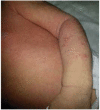Dermal and Ophthalmic Findings in Pseudohypoaldosteronism
- PMID: 26316441
- PMCID: PMC4563190
- DOI: 10.4274/jcrpe.1740
Dermal and Ophthalmic Findings in Pseudohypoaldosteronism
Abstract
Pseudohypoaldosteronism (PHA) is defined as a state of resistance to aldosterone, a hormone crucial for electrolyte equilibrium. The genetically transmitted type of PHA is primary hypoaldosteronism. Secondary hypoaldosteronism develops as a result of hydronephrosis or hydroureter. PHA patients suffer from severe hyponatremia and a severe clinical condition due to severe loss of salt can be encountered in the neonatal period. Dermal findings in the form of miliaria rubra can also develop in these patients. With the loss of salt, abnormal accumulation of sebum in the eye due to a defect in the sodium channels can also occur. In this paper, a case of PHA in a newborn showing typical dermatological and ophthalmological findings is presented.
Figures
Similar articles
-
[Pustular miliaria rubra and systemic type 1b pseudohypoaldosteronism in a newborn].Ann Dermatol Venereol. 2007 Mar;134(3 Pt 1):253-6. doi: 10.1016/s0151-9638(07)91819-0. Ann Dermatol Venereol. 2007. PMID: 17389851 French.
-
Newborn with pseudohypoaldosteronism and miliaria rubra.Int J Dermatol. 2006 Dec;45(12):1432-4. doi: 10.1111/j.1365-4632.2006.02936.x. Int J Dermatol. 2006. PMID: 17184247 No abstract available.
-
Fetal pseudohypoaldosteronism: another cause of hydramnios.Acta Paediatr. 1995 May;84(5):582-4. doi: 10.1111/j.1651-2227.1995.tb13701.x. Acta Paediatr. 1995. PMID: 7633160
-
Novel mutations in epithelial sodium channel (ENaC) subunit genes and phenotypic expression of multisystem pseudohypoaldosteronism.Clin Endocrinol (Oxf). 2005 May;62(5):547-53. doi: 10.1111/j.1365-2265.2005.02255.x. Clin Endocrinol (Oxf). 2005. PMID: 15853823 Review.
-
Transient pseudohypoaldosteronism: a potentially severe condition affecting infants with urinary tract malformation.J Pediatr Urol. 2019 May;15(3):265.e1-265.e7. doi: 10.1016/j.jpurol.2019.03.002. Epub 2019 Mar 9. J Pediatr Urol. 2019. PMID: 30962012 Review.
Cited by
-
Expression of epithelial sodium channel (ENaC) and CFTR in the human epidermis and epidermal appendages.Histochem Cell Biol. 2017 Jun;147(6):733-748. doi: 10.1007/s00418-016-1535-3. Epub 2017 Jan 27. Histochem Cell Biol. 2017. PMID: 28130590
-
Dermatologic Manifestations of Endocrine Disorders.Cureus. 2021 Sep 27;13(9):e18327. doi: 10.7759/cureus.18327. eCollection 2021 Sep. Cureus. 2021. PMID: 34692360 Free PMC article. Review.
References
-
- Riepe FG. Clinical and molecular features of type 1 pseudohypoaldosteronism. Horm Res. 2009;72:1–9. - PubMed
-
- Tütüncüler F, Günöz H, Bas F, Bundak R, Saka N, Neyzi O. Transient pseudohypoaldosteronism in an infant with urinary tract anomaly. Pediatr Int. 2004;46:618–620. - PubMed
-
- Büyükkayhan D, Köklü E, Görözen F, Kurtoğlu S, Hatipoğlu N, Gündüz Z. An endocrine problem of obstructive uropathy:pseudohypoaldosteronism. Erciyes Medical Journal. 2007;29:82–85.
-
- Geller DS. Mineralocorticoid resistance. Clin Endocrinol (Oxf) 2005;62:513–520. - PubMed
-
- Hanukoglu A. Type I pseudohypoaldosteronism includes two clinically and genetically distinct entities with either renal or multiple target organ defects. J Clin Endocrinol Metab. 1991;73:936–944. - PubMed
Publication types
MeSH terms
Substances
LinkOut - more resources
Full Text Sources
Other Literature Sources
Medical



